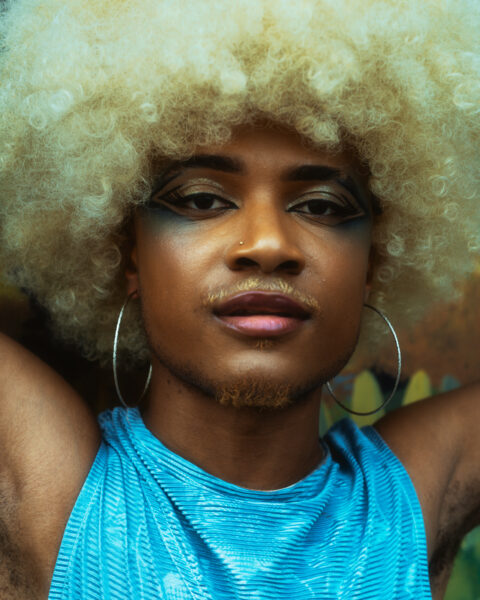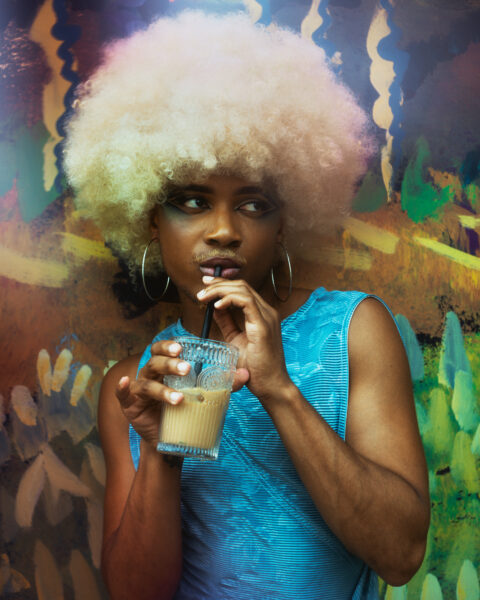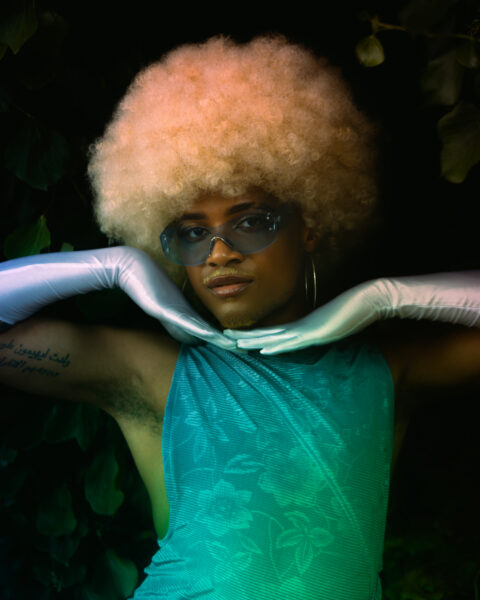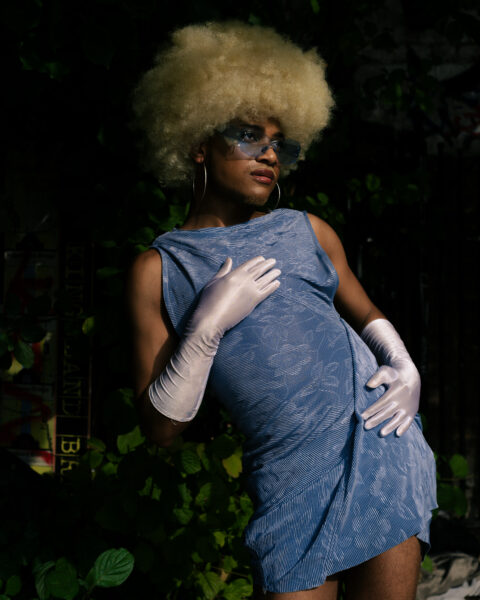The Berlin-based newcomer and member of the local music community, Sedric Perry released two new singles this year. “Papi Champu” and “It Girl” celebrate self-expression and spread good vibes. Influenced by genres like RnB, 80s pop, and disco, the songs pack catchy hooks but also deeply emotional messages. To Sedric, music is a way to channel emotions and release them. “I was a real emotional kid, still am, to be honest”, he recalls. “I used to randomly cry all the time, but could never express myself or say why. Music really helped me to manage myself, I think it is similar for many artists.”
Music has played an important role in Sedric’s life since childhood. Growing up in the United States, Philadelphia, the atmosphere at home was filled with, as Sedric describes, “gospel music from my mom’s side and Reggae, Jazz and old school RnB from my dad’s”. Those genres are the musical blueprint, but the artist that Sedric Perry grew up to be, evades genre definitions and expresses a wide range of different moods.


Giving Yourself Permission
It makes sense then, that Sedric Perry does not like to be labeled as one thing. “I am evolving and learning and sharing what I gather”, the singer says. The impact of the songs stretches across time as Sedric grows as an artist, songwriter, and person. Talking about the different moods, the singer highlights “Love In You” as one of the more mellow songs written “at home in a very meditative space”. The latest single, “Papi Champu”, on the other hand, channels a different energy. Sedric describes it as a “nod to a much more rambunctious and younger Sedric. I carry him with me, and he gives me permission to fuck it up when I need to.”

“This era of my life is about giving myself permission to have fun and try new things, but from a wiser place.”
The recent singles like the music videos channel that spirit. Sedric Perry sounds confident and reassured about the path he is taking, but the things that led him there were not always easy. “It Girl”, for example, grew out of a dark period of time following the loss of his father. Sedric speaks openly about the way this loss shaped him: “Something happens to you when you lose someone so close. I felt like all the systems that I fought so hard to build, just broke down. But then all of a sudden, music stopped being this job that I had to put my ten thousand hours into. It transformed into my healing vehicle again. I literally healed my heart by singing. I was surrounded by so much love, friends, and family that it somehow became a beautiful experience. My relationship to music shifted back to the purity it was in the beginning and I was curious and open to everything again.”
Following this experience, the artist released the songs “FTS” and “CTB”, which give musical and lyrical expression to the “highs and lows of loss, love and gratitude”. “It Girl” finally becomes a full-circle kind of moment and a return to the playful joy of making music. “It is me declaring to myself and everyone else that we still have so many gifts to give this world”, Sedric says.
Confidence and Community
 In the process of healing, the community played an important role. Sedric Perry has performed and recorded with many artists from the Berliner soul and RnB scene and is a vital part of the Black music community in the German capital. Sedric describes the local scene as having changed a lot since he moved there a few years ago. Back then, he recounts: “A lot of us were just starting out, so it is amazing to see how we have all grown. The community is so much bigger now. It is beautiful to see the seeds we have sown grow into a whole landscape. There is still a lot to be done but this environment helped me define the artist I hope to become someday.”
In the process of healing, the community played an important role. Sedric Perry has performed and recorded with many artists from the Berliner soul and RnB scene and is a vital part of the Black music community in the German capital. Sedric describes the local scene as having changed a lot since he moved there a few years ago. Back then, he recounts: “A lot of us were just starting out, so it is amazing to see how we have all grown. The community is so much bigger now. It is beautiful to see the seeds we have sown grow into a whole landscape. There is still a lot to be done but this environment helped me define the artist I hope to become someday.”
A performance that brought this experience of community onto a stage was Noah Slee’s it takes a village show in 2022, which featured Sedric alongside alongside his long-term collaborator K.ZIA and other artists like Mulay and LIE NING. Sedric Perry wore a dress made out of silver chains, bright red over-knee high-heels, and a durag. His outfit was certainly a showstopper and fashion continues to be part of the artist’s way of self-expression. The artwork of the recent single “It Girl” shows him posing on a magazine cover and the accompanying music video returns to 80s looks with Sedric performing in a pink glitter overall, a low neckline revealing his chest. The aesthetic draws on iconic artists like Prince and Sylvester who played with non-heteronormative gender expression. “I think people still take gender norms way too seriously”, Sedric says. “[Fashion] is not my biggest focal point but I love breaking my own boundaries and exploring. Anything that helps me do that, I’ll try. Me on stage in a ridiculous wig and dress can disarm people. Then I can pass a positive message and invite people to express themselves too. I remember a show where the guy who booked me was telling me how much he loved my leotard but was scared to wear stuff like that. I told him to try it on and I could tell it made him feel confident and sexy. In that respect, I love fashion.”
In the Footsteps
Music and looks go hand in hand on the 80s-inspired “It Girl”. The song pays homage to the aesthetics and music of iconic singers like Prince and Whitney Houston. Like many before him, Sedric Perry expresses his creative characters through music and aesthetics. Honoring the long lineage of boundary-breaking artists, Sedric contributes something new himself. “There is something about the way [Prince], Michael Jackson, Little Richard, and so many others express themselves. It is so uniquely them, but you can tell they have a lot of reverence for those who came before them. I want art to be so impactful on those who experience it that you can’t help but hold a mirror to yourself and question some part of your belief system and why you shouldn’t be able to appreciate my art.”
By breaking with heteronormative gender stereotypes and binaries, Sedric Perry opens up a realm for exploration and self-expression that continues to inspire others. But this confident embodiment of his identity is not something that came without work. In an interview with Curl Con, Sedric talks about struggling to come to terms with his sexuality before embracing it. Has music and performing on stage helped to come to a point of celebrating identity? Sedric says: “Absolutely. If I wasn’t a performer, I don’t know if I would have the same bravery. At this point, I’m just letting my inner child have his day and I watch the videos back like ‘Go lil Sed!’”

Alignment and Queer Visibility
Celebration and joy are at the core of some of the newest releases like “It Girl” and “Papi Champu”. But there were some key moments – not always easy ones – that shaped the artist Sedric is today. Coming to terms with sexuality, and dealing with loss and grief over the passing of his father are some of those moments. Another experience that transformed Sedric Perry was his time in Senegal, which as he writes in the caption of the music video to “CMB” shot in the West African country, changed him forever. He says: “Senegal opened my eyes in a lot of ways to the reality some people face every day. I saw how creative and innovative we can be. I was also faced with how colonization and poverty can affect the mind of a people. Senegal charged me with a kind of strength I can’t explain. It also made me aware of a lot of my privileges having lived in cities like New York and Berlin. Queer people can’t walk around in Dakar in the ways I can back home.”

“I am a firm believer that none of us are free until we all are. My art is charged with this message, sometimes more than others, and I really don’t care if people don’t like it. My sense of responsibility got heavier.”
Sedric Perry shows that celebration can also mean resistance and resilience in the face of discrimination. Being a visibly queer person who celebrates their identity publicly, creates much-needed queer and Black queer visibility. For all the youngsters looking for someone who makes them feel seen and valued, an artist like Sedric can be a guiding light in a heteronormative society.
There remains one more question to ask this rising artist. What is something that you wish for in terms of your music career? “I wish for alignment”, Sedric answers. “I have seen so much in my life. At this point, I am just trusting the process and showing up. What is mine is already on its way to me. In the grand scheme, I want to save lives. Queer visibility saved my life. I want to pass that on to someone else with all my heart.”
“Papi Champu” is out now via Sundae Sauuce.
Every few weeks, the NBHAP staff brings an exciting new artist to your attention alongside a 30-track-strong Introducing Playlist on Spotify. Feel invited to follow the playlist and give these talents a spin. Sign up for our Newsletter to receive monthly updates about new music.
This week’s playlist update was curated in collaboration with Sedric Perry. Alongside the new tracks “It Girl” and “Papi Champu” it includes personal inspirations from artists such as Caxxianne, K.ZIA, Sam Ezeh, and more. Tune in below.
